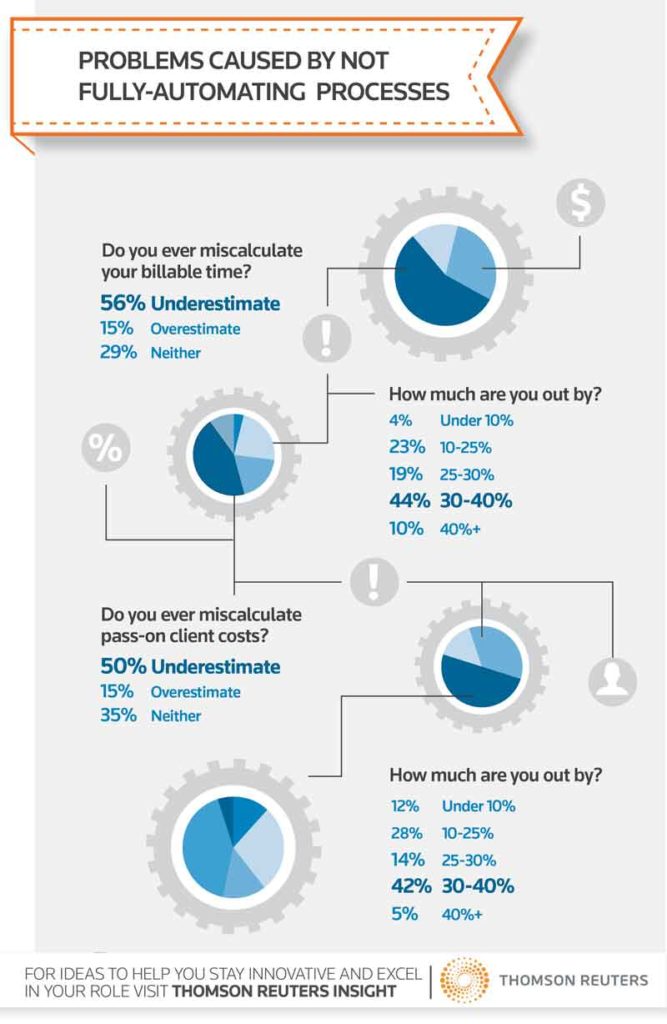We recently conducted a study which has revealed law firms could be needlessly wasting hundreds of hours each year and miscalculating tens of thousands in billable time because of a lack of specialist training and adoption of new technologies.
- 76% claim their lack of technology knowledge wastes ‘significant firm time
- Only 11% of firms offer training for new technologies
- Automated process can save up to 50% compared with legacy methods
More than 80* senior fee-earning legal practitioners in medium-large practices were questioned in our August 2013 survey to help us understand how law firms use practice management and research technologies. A lack of knowledge was a common trend, with just 11% claiming their firm offered formalised training for newly adopted technologies. Only 17% said they got the most out of the current workflow and research tools at their disposal and the majority (76%) claimed this had a negative impact on their time efficiency.
A large number of professionals also rely exclusively on ‘manual’ processes for day-to-day tasks, despite fully-automated computer-based processes being available, including workflow management (41%), legal research (38%), tracking billable time (37%), client cost-ledger (35%), document management (31%), and document production/assembly (19%).
Conversely, the survey highlighted the potential time savings offered by fully automated solutions, including workflow management (50% average time saving compared to the manual process) legal research (50%), document production/assembly (50%), tracking billable time (25%), client cost leger (25%) and document management (25%).
The top reasons for this lack of adoption emerged as greater trust in ‘traditional’ legacy methods (43%) and technophobia (32%) from users.
Miscalculation
The study also highlighted a number of other issues impacting a firm’s potential profitability due to lack of technology. Of those professionals manually tracking billable time, 56% admitted they generally underestimated their hours. This is compared to just 18% of those who fully automated the process. And, with an average inaccuracy of 30-40%, there is some serious billable time being lost.
The same can be said for manually tracking client cost-ledger, with 50% of firms underestimating ‘recharge’ costs, by an average of a quarter. The research also highlighted a dearth of fee-earner time analysis, with just 21% of firms analysing fee earner’s figures on a monthly basis. 16% did this every six months, 37% yearly, while 19% never did it.
Carl Olson, ANZ Product Management Director, Thomson Reuters Legal, comments: “It’s surprising to see so many firms still relying on so-called ‘manual’ processes, despite the availability of proven and trusted time-saving alternatives such as online research portals and sophisticated practice management software. In some cases this costs time, but when a fee earner undercharges their hours, it’s a case of directly losing money. Firms that fail to adopt new technologies leave themselves open to being less competitive than those that do.”
How much is this really costing?
Underestimating fee earner’s time by 40%. Based on a typical senior solicitor’s charge out rate of $300 per hour, this equates to a potential $20,000 a month in lost revenue. Based on an average partner’s hourly rate of $800, this rockets to more than $51,000 a month.
Document assembly time savings of 50% with automated solutions. According to recent research, taking instructions and drafting one of three types of common legal document takes an average of 86 minutes**, meaning automated solutions could save 46 minutes. Based on producing just three documents per week, a senior solicitor could be wasting $2,760 each month in lost billable time.
Sources:
*Study questioned 80 senior staff/partners across medium-large law firms in Australia
**According to a 2011 study by LegalFutures



